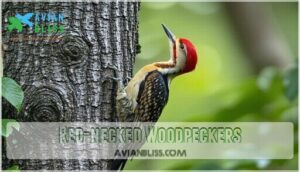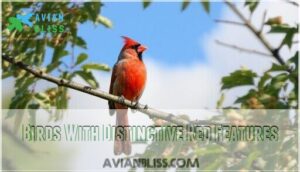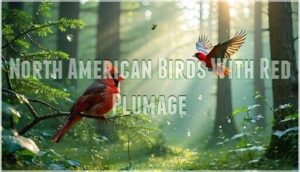This site is supported by our readers. We may earn a commission, at no cost to you, if you purchase through links.

These striking color combinations aren’t just eye candy—they’re evolutionary masterpieces that serve vital functions in mating displays and territorial communication.
From the iconic Northern Cardinal’s brilliant crimson plumage to the dramatic contrast of woodpeckers’ bold markings, these birds command attention wherever they appear.
Whether you’re spotting a Rose-breasted Grosbeak at your backyard feeder or admiring exotic Crimson Collared Tanagers in tropical regions, black and red birds showcase evolution’s flair for dramatic design.
The stark contrast between deep black and vibrant red creates patterns that are impossible to ignore, making these species favorites among birdwatchers and photographers alike.
These remarkable birds reveal fascinating secrets about survival, attraction, and adaptation.
Table Of Contents
- Key Takeaways
- Birds With Black and Red Plumage
- Woodpeckers With Red Markings
- Birds With Distinctive Red Features
- Tanagers With Black and Red Feathers
- North American Birds With Red Plumage
- Frequently Asked Questions (FAQs)
- What birds are red and black?
- What is a red winged blackbird?
- What bird has a red head?
- What bird has a Red Wing?
- How many black & red birds are there?
- What does a black bird look like?
- What type of bird is red and black?
- Why are redwing blackbirds so aggressive?
- Is it rare to see a red-winged blackbird?
- What does it mean when you see a red and black bird?
- Conclusion
Key Takeaways
- You’ll find black and red birds showcase evolutionary masterpieces where dramatic color contrasts serve vital functions in mating displays, territorial communication, and survival strategies rather than just aesthetic appeal.
- You’ll encounter diverse species from Northern Cardinals with brilliant red plumage and black masks to Red-winged Blackbirds flashing crimson shoulder patches, each adapted to specific habitats from backyard feeders to tropical forests.
- You’ll discover these striking birds include woodpeckers like Pileated Woodpeckers with red crests, tanagers with seasonal color changes, and specialized species like Great Frigatebirds that inflate red throat pouches during courtship.
- You’ll benefit from understanding their behaviors and habitats since many species like Cardinals don’t migrate while others like Scarlet Tanagers travel thousands of miles seasonally, making successful birdwatching encounters crucial for timing.
Birds With Black and Red Plumage
You’ll discover stunning birds that showcase nature’s most striking color combination through their bold black and red plumage patterns.
These species demonstrate remarkable adaptations where contrasting colors serve both identification and survival purposes in their natural habitats, highlighting the importance of bold color patterns.
Northern Cardinals
You’ll immediately recognize Northern Cardinals by their stunning contrast of fiery red plumage and jet-black facial masks.
These Cardinal species showcase remarkable Cardinal Behavior throughout the year, with males defending territories using distinctive Song Patterns that range from clear whistles to complex chirps.
Unlike many Black and red birds, Northern Cardinals don’t follow Migration Routes – they’re year-round residents.
Their Nesting Habits involve building cups in dense shrubs, while Feather Care maintains their vibrant appearance.
These Red Cardinals differ substantially from Redwinged Blackbirds in their stocky build and prominent crests.
Tricolored Blackbirds
While Northern Cardinals dominate backyards year-round, you’ll spot Tricolored Blackbirds showcasing their dramatic red shoulder patches bordered in white across California’s wetlands.
These black bird species face serious Bird Conservation challenges due to Tricolored Habitat loss.
Tricolored Behavior differs from Redwinged Blackbird patterns through their colonial nesting habits and Blackbird Migration timing.
- Red Plumage patches feature distinctive white borders unlike yellow-bordered relatives
- Tricolored Blackbird species form massive colonies exceeding 100,000 individuals
- Males defend territories aggressively during breeding season
- Tricolored Blackbirds prefer emergent wetland vegetation for nesting
- Black and red birds like these face 63% population decline since 1930s
Understanding the impact of bird conservation efforts is vital to protecting these species.
Crimson Collared Tanagers
Moving from Tricolored Blackbirds to tropical landscapes, you’ll discover Crimson Collared Tanagers showcasing nature’s boldest palette.
These Forest Dwellers exhibit stunning Crimson Feathers across their heads and necks, contrasting sharply with jet-black wings.
Their Red Crests distinguish them from Northern Cardinals and Scarlet Tanagers in Tanager Habitat preferences.
| Feature | Description | Habitat Preference |
|---|---|---|
| Plumage | Bright crimson head/neck, black back | Dense tropical forests |
| Diet | Fruits and insects | Canopy levels |
| Nesting | High branch construction | Humid woodlands |
| Behavior | Social foraging groups | Year-round residents |
Rose-breasted Grosbeaks
You’ll discover the Rose-breasted Grosbeak’s striking black and red birds plumage transforms woodland encounters into unforgettable experiences.
These medium-sized songbirds showcase distinctive Feather Patterns that rival Northern Cardinals in visual impact.
Their remarkable characteristics include:
- Beak Structure perfectly adapted for cracking seeds and catching insects
- Nesting Habits favor dense deciduous canopies for protection
- Bird Migration patterns span from Canada to Central America seasonally
Habitat Conservation efforts protect these Rosebreasted Grosbeak populations, ensuring future generations can witness their melodious territorial calls echoing through forest corridors during breeding season.
Red-bellied Woodpeckers
Beyond the Rose-breasted Grosbeak, you’ll discover the fascinating Red-bellied Woodpecker, a master of Forest Ecology.
These woodpeckers don’t actually have red bellies—their Red Belly shows subtle orange-red hues while their heads display brilliant crimson plumage.
Woodpecker Habitat includes mature oak and pine forests where they excavate nesting cavities.
Their Woodpecker Diet consists of insects, nuts, and fruits, making them essential for pest control.
Unlike the Redheaded Woodpecker, this species shows less dramatic Bird Migration patterns, remaining year-round residents in suitable territories.
Bird watching enthusiasts can distinguish Redbellied Woodpeckers from other woodpecker species by their distinctive calls and feeding behaviors.
| Characteristic | Details |
|---|---|
| Size | 9-10 inches long with 13-16 inch wingspan |
| Habitat | Deciduous forests, parks, wooded suburbs |
| Diet | Insects, nuts, fruits, occasional small reptiles |
These adaptable birds thrive in various environments, from deep forests to suburban backyards with mature trees.
Woodpeckers With Red Markings
You’ll find some of North America’s most impressive woodpeckers display striking red markings against their black and white plumage.
These powerful birds use their specialized beaks and strong necks to excavate insects from tree bark, creating the distinctive drumming sounds that echo through forests.
Pileated Woodpeckers
You’ll find Pileated Woodpeckers commanding attention in mature Woodpecker Habitat with their crow-sized frames and brilliant Red Markings adorning their prominent crests.
These impressive woodpeckers demonstrate fascinating Pileated Behavior as they excavate large rectangular holes in dead trees, creating essential nesting sites that benefit Forest Ecology for years to come.
Woodpecker Conservation efforts recognize their importance as ecosystem engineers:
- They control carpenter ant populations and wood-boring beetle larvae
- Their abandoned nest cavities provide homes for other wildlife species
- They indicate healthy forest conditions during bird watching expeditions
Unlike Redheaded Woodpeckers or Redbellied Woodpecker species, Pileated Woodpeckers mate for life and share parenting duties equally, demonstrating remarkable cooperation in raising their young through forest restoration efforts.
The study of Pileated Woodpecker behavior and habitat often involves woodpecker gift items that help support conservation efforts.
Red-necked Woodpeckers
You’ll spot Red-necked Woodpeckers hammering through South America’s dense forests, their crimson heads blazing against dark bark.
Their specialized woodpecker diet supports essential forest ecology while their bright red neck feathers make identification easy.
The study of woodpecker wildlife products helps raise awareness about the importance of preserving their natural habitats.
These skilled hunters extract insects and grubs from tree crevices, creating that familiar rat-a-tat-tat rhythm.
Bird conservation efforts protect their woodpecker habitat from deforestation threats.
Birds With Distinctive Red Features
You’ll encounter some birds that use red features strategically rather than covering their entire bodies with this vibrant color.
These species showcase red as accent marks, breeding displays, or specialized body parts that serve specific biological functions.
Male Red-breasted Meadowlarks
Throughout Costa Rica’s moist grasslands, male Red-breasted Meadowlarks showcase their brilliant crimson chests during breeding season.
These black and red birds captivate observers with their distinctive appearance and melodious calls. The study of birds with red chests helps understand their mating and territorial behaviors.
- Listen for their rich Meadowlark Songs echoing across meadow habitats
- Watch for bright Red Breasts contrasting against darker plumage
- Observe their ground-foraging Breeding Behaviors during nesting season
- Track Bird Migration patterns as Redbreasted Meadowlarks move seasonally
Male Great Frigatebirds
You’ll recognize male Great Frigatebirds by their striking red gular sacs that inflate like balloons during frigatebird mating displays.
These magnificent seabirds cruise tropical waters with wingspans reaching 7.5 feet, showcasing black plumage with green iridescence.
Their seabird habitat spans vast oceanic regions where they practice kleptoparasitism and surface feeding for their frigatebird diet of flying fish.
Male Bare-necked Umbrellabirds
While Great Frigatebirds command attention with their inflated throat pouches, the Male Bare-necked Umbrellabird presents an entirely different spectacle.
This remarkable black bird species displays striking red plumage concentrated around its bare neck and throat, creating a dramatic contrast against its otherwise jet-black feathers.
These impressive red birds inhabit cloud forests of Central and South America, where Umbrellabird Habitat consists of dense canopy layers.
Their Bare Neck Features serve important thermoregulatory functions in humid tropical environments.
Here are three key identification points for spotting these magnificent bird species:
- Distinctive umbrella-shaped crest that expands during territorial displays
- Bright red throat wattle contrasting sharply with black plumage
- Large size reaching up to 20 inches in length.
Unlike Northern Cardinals that remain year-round residents, these birds engage in limited Bird Migration patterns following fruit availability.
Their specialized Umbrellabird Diet focuses primarily on fruits, though they’ll occasionally consume insects during breeding season.
Proper bird identification requires noting their unique combination of size, coloration, and habitat preferences.
Pesquet’s Parrots
You’ll find Pesquet’s parrots exclusively in New Guinea’s rainforests, where their distinctive red and black plumage makes them unmistakable among black and red birds.
These remarkable bird species exhibit unique Parrot Behavior, feeding primarily on figs while demonstrating complex social interactions.
| Feature | Description |
|---|---|
| Wing Structure | Broad wings adapted for forest canopy navigation |
| Beak Health | Powerful bills designed for fig consumption |
| Nesting Habits | Single egg clutches in tree hollows |
Conservation efforts focus on protecting their habitat, as deforestation threatens these magnificent red birds.
Their slow reproduction rate—one egg per season—makes population recovery challenging.
Proper Feather Care in captivity requires specialized attention to maintain their vibrant coloration for bird identification purposes.
Tanagers With Black and Red Feathers
Among the most enchanting black and red birds, tanagers stand out with their brilliant plumage and fascinating behaviors.
These small songbirds showcase nature’s artistry through striking feather patterns that make birdwatchers stop in their tracks.
Crimson Collared Tanagers display the most dramatic contrast—glossy black wings against vibrant red crests and collars. You’ll find these beauties in Central American tropical forests, where their scarlet songs echo through the canopy.
Scarlet Tanagers offer different seasonal displays, with males showing blood-red bodies and jet-black wings during breeding season.
Here’s what makes tanagers special:
- Feather Patterns: Males exhibit more intense red coloration than females, creating stunning visual displays during courtship rituals.
- Tanager Migration: Some species undertake remarkable journeys, traveling thousands of miles between breeding and wintering grounds.
- Foraging Behavior: They’re skilled hunters, catching insects mid-flight while also consuming fruits, making them important seed dispersers.
Redbreasted Sapsuckers round out this group, showing how diverse black and red birds can be across different families. Understanding the impact of habitat loss threats is vital for conservation efforts aimed at protecting these species.
North American Birds With Red Plumage
Northern Cardinals dominate backyards across eastern and central regions, their brilliant red plumage catching sunlight like living flames. These non-migratory residents showcase Red Plumage Genetics through carotenoid pigments absorbed from their diet, creating that signature crimson coat.
Scarlet Tanagers migrate through North American Habitats, displaying fiery bodies with jet-black wings during breeding season. Their Red Bird Migration patterns span from Canada to South America, making spring sightings truly special.
Red-winged Blackbirds flash crimson shoulder patches in marshlands, while Red-breasted Sapsuckers drill neat rows of holes in western forests. Crimson Collared Tanagers occasionally venture north from tropical regions.
Understanding Bird Feeding Habits helps locate these species – cardinals prefer sunflower seeds, while tanagers hunt insects in canopy levels. Bird Conservation Efforts focus on protecting wetland habitats for blackbirds and maintaining mature forests for woodpeckers.
Each species demonstrates unique adaptations within their specialized ecosystems, creating diverse opportunities for memorable wildlife encounters. The red breasted merganser exhibits fascinating diving behavior patterns that showcase its remarkable adaptability in various aquatic environments.
Frequently Asked Questions (FAQs)
What birds are red and black?
You’ll spot several striking red and black birds across North America.
Cardinals showcase brilliant red plumage with black face masks, while Scarlet Tanagers display blood-red bodies with jet-black wings during breeding season.
What is a red winged blackbird?
You’ll encounter this striking marsh-dweller across North America’s wetlands.
Red-winged blackbirds are glossy black birds with bright red shoulder patches bordered by yellow.
Males boldly display these crimson epaulets during territorial disputes and courtship rituals, showcasing their bright red shoulder patches.
What bird has a red head?
You’ll encounter several bird species with vibrant red heads.
Northern Cardinals display bright red crests and heads, while Red-headed Woodpeckers feature bold red caps.
Pileated Woodpeckers sport red crests on their massive frames, breaking free from typical songbird expectations.
What bird has a Red Wing?
Ever wondered which bird flashes crimson patches during territorial displays?
You’ll spot the Red-winged Blackbird, where males showcase glossy black plumage with brilliant red shoulder patches bordered by yellow, creating nature’s perfect warning signal in marshes and wetlands.
How many black & red birds are there?
You’ll find approximately 12-15 distinct black and red bird species in North America, including cardinals, tanagers, blackbirds, and woodpeckers that showcase this striking color combination.
What does a black bird look like?
Blackbirds boast brilliant ebony plumage that gleams with iridescent qualities.
You’ll notice their sleek, streamlined bodies feature glossy black feathers covering wings, tail, and torso.
Males typically display deeper, more lustrous coloring than females during breeding season.
What type of bird is red and black?
You’ll spot several red and black bird species across North America.
Northern Cardinals display bright red bodies with black masks, while Red-winged Blackbirds sport glossy black plumage with red shoulder patches.
Why are redwing blackbirds so aggressive?
Ironically, these "peaceful" songbirds become fierce warriors when protecting their territory and nest.
You’ll witness their aggressive behavior during breeding season when males defend marsh territories through aerial attacks, calls, and displays against perceived threats, exhibiting aggressive behavior.
Is it rare to see a red-winged blackbird?
Red-winged blackbirds aren’t rare at all—you’ll easily spot these territorial males flashing their crimson shoulder patches in marshes, wetlands, and grasslands across North America during breeding season.
What does it mean when you see a red and black bird?
Seeing a red and black bird typically indicates you’ve encountered a common North American species like a Northern Cardinal, Red-winged Blackbird, or Scarlet Tanager.
Each of these species has distinct seasonal behaviors and habitats.
Conclusion
Nature’s paintbrush has created masterpieces in black and red birds that continue enchanting observers worldwide.
These species demonstrate how coloration serves essential biological functions beyond mere aesthetics, and each species tells a unique evolutionary story.
Whether you’re documenting Northern Cardinals in your backyard or tracking exotic tanagers in tropical forests, you’ll discover the significance of these birds.
The dramatic contrast between black and red plumage makes these birds unforgettable subjects for photography and study, ensuring their place among nature’s most striking avian ambassadors with a lasting impression of their biological functions.
- https://beyondyourbackdoor.net/2021/05/19/a-black-winged-red-bird/
- https://news.maryland.gov/dnr/2025/03/21/native-animal-profile-red-winged-blackbird/
- https://abcbirds.org/bird/tricolored-blackbird/
- https://www.birdsandblooms.com/birding/bird-photography/red-bird/
- https://www.allaboutbirds.org/guide/Red-winged_Blackbird/lifehistory







